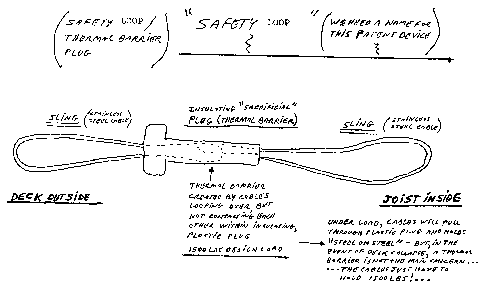Some of the information on this Web page has been provided by external sources. The Government of Canada is not responsible for the accuracy, reliability or currency of the information supplied by external sources. Users wishing to rely upon this information should consult directly with the source of the information. Content provided by external sources is not subject to official languages, privacy and accessibility requirements.
Any discrepancies in the text and image of the Claims and Abstract are due to differing posting times. Text of the Claims and Abstract are posted:
| (12) Patent Application: | (11) CA 2714848 |
|---|---|
| (54) English Title: | DECK-TO-BUILDING LATERAL-LOAD CONNECTOR |
| (54) French Title: | CONNECTEUR DE CHARGE LATERALE POUR TERRASSE A BATIMENT |
| Status: | Deemed Abandoned and Beyond the Period of Reinstatement - Pending Response to Notice of Disregarded Communication |
| (51) International Patent Classification (IPC): |
|
|---|---|
| (72) Inventors : |
|
| (73) Owners : |
|
| (71) Applicants : |
|
| (74) Agent: | GOWLING WLG (CANADA) LLP |
| (74) Associate agent: | |
| (45) Issued: | |
| (22) Filed Date: | 2010-09-16 |
| (41) Open to Public Inspection: | 2012-03-16 |
| Availability of licence: | N/A |
| Dedicated to the Public: | N/A |
| (25) Language of filing: | English |
| Patent Cooperation Treaty (PCT): | No |
|---|
| (30) Application Priority Data: | None |
|---|
A device for connecting an exterior deck structure to a contiguous building
has a pair
of interlocked cables, with a plastic plug encapsulating the interlocked ends
of the
cables and separating the cables to act as a thermal barrier. An expanded head
at one
end of the plug, with associated foam washer seals against a deck header,
while the
exterior cable end of the device is connected to a deck joist and the interior
end of the
cable device is connected to a building joist, wherein the joists may be
laterally offset.
Note: Claims are shown in the official language in which they were submitted.
Note: Descriptions are shown in the official language in which they were submitted.

2024-08-01:As part of the Next Generation Patents (NGP) transition, the Canadian Patents Database (CPD) now contains a more detailed Event History, which replicates the Event Log of our new back-office solution.
Please note that "Inactive:" events refers to events no longer in use in our new back-office solution.
For a clearer understanding of the status of the application/patent presented on this page, the site Disclaimer , as well as the definitions for Patent , Event History , Maintenance Fee and Payment History should be consulted.
| Description | Date |
|---|---|
| Time Limit for Reversal Expired | 2013-09-17 |
| Application Not Reinstated by Deadline | 2013-09-17 |
| Inactive: IPC assigned | 2012-11-30 |
| Inactive: IPC assigned | 2012-11-30 |
| Inactive: IPC assigned | 2012-11-30 |
| Inactive: IPC assigned | 2012-11-30 |
| Deemed Abandoned - Failure to Respond to Maintenance Fee Notice | 2012-09-17 |
| Application Published (Open to Public Inspection) | 2012-03-16 |
| Inactive: Cover page published | 2012-03-15 |
| Inactive: IPC assigned | 2010-10-27 |
| Inactive: IPC assigned | 2010-10-27 |
| Inactive: IPC assigned | 2010-10-21 |
| Inactive: First IPC assigned | 2010-10-21 |
| Inactive: Filing certificate - No RFE (English) | 2010-10-05 |
| Letter Sent | 2010-10-05 |
| Application Received - Regular National | 2010-10-05 |
| Abandonment Date | Reason | Reinstatement Date |
|---|---|---|
| 2012-09-17 |
| Fee Type | Anniversary Year | Due Date | Paid Date |
|---|---|---|---|
| Application fee - standard | 2010-09-16 | ||
| Registration of a document | 2010-09-16 |
Note: Records showing the ownership history in alphabetical order.
| Current Owners on Record |
|---|
| ULI WALTHER |
| GERDA WALTHER |
| MIRCO WALTHER |
| Past Owners on Record |
|---|
| BERND WALTHER |